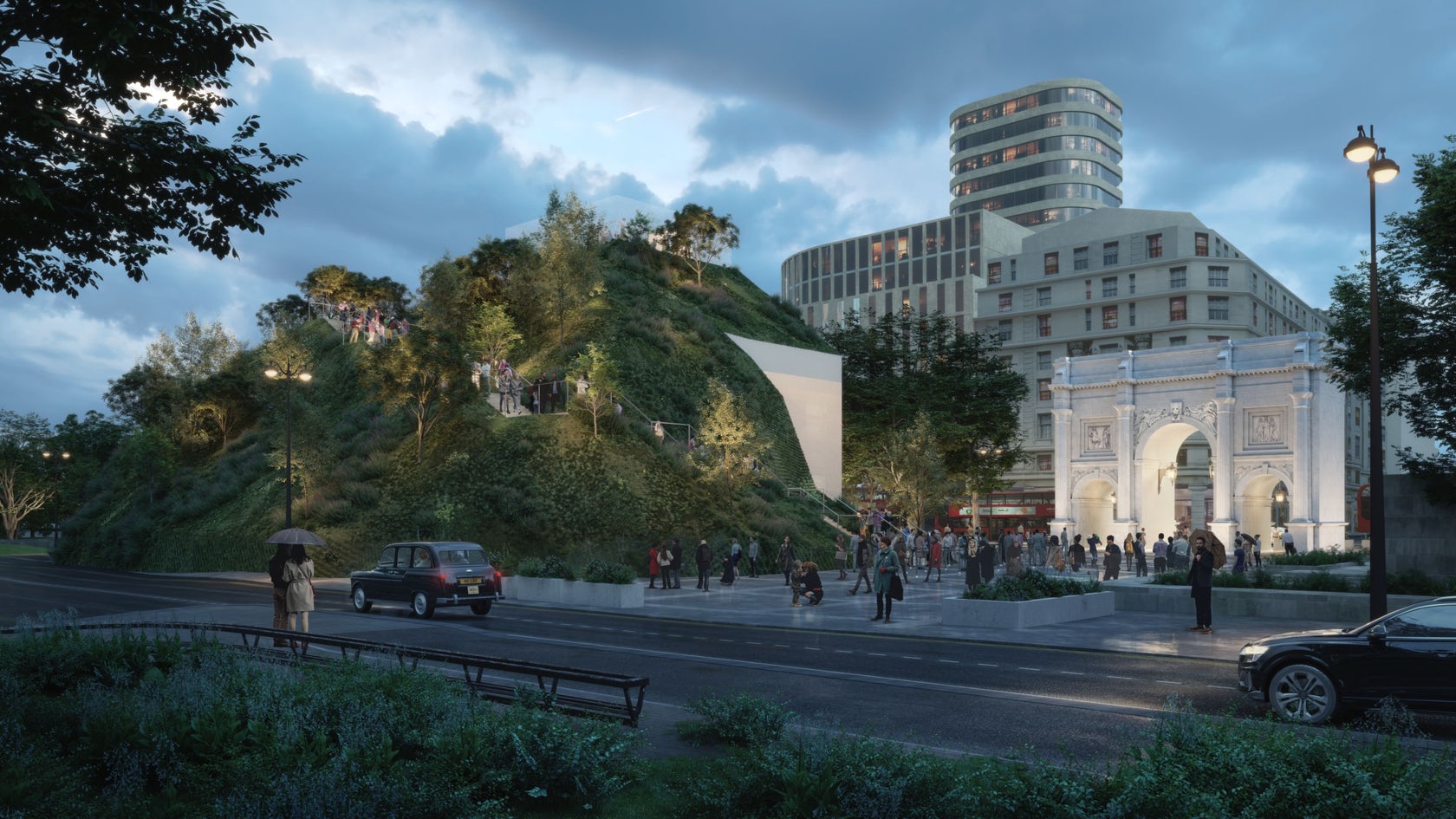Last chance: The 14th Architizer A+Awards celebrates architecture's new era of craft. Apply for publication online and in print by submitting your projects before the Final Entry Deadline on January 30th!
In July 2021, MVRDV completed a temporary artificial green hill next to the Marble Arch on London’s famous Oxford street. However, it was soon shut at the end of the month for booking and visiting as the overwhelming negative feedbacks reminded the Westminster City Council that it was “not ready.” Comparing the conceptual rendering of the Marble Arch Mound to its reality in July, it is not hard to figure out why some people were so disappointed, wondering why they were charged entry fees for a seemingly incomplete experience.
Where were the fluffy, luxuriant vegetation, comprising different species of grass turf, bushes and trees, that so harmonically contrasted the urban context in the visualizations? In reality, the grass — replaced by the sedum turf — appeared unhealthily brown and thin, barely covering the rigid structures underneath.

Visualization of Marble Arch Hill, image via MVRDV

Photo of Marble Arch Mound, image via Dezeen
When we look closer to the gaps between rendering and reality, is it reasonable to only attribute them to the unforeseen local weather or elusive plant growth habits? In this case, MVRDV defended the project, saying that plants required more time under London’s “unexpected dry weather.” Despite the well-intentioned message of bringing more greens into the city to alleviate the urban hot island effect, how much time would be left for us to enjoy a “ready” Marble Arch Mound before its planned closure in January 2022? What’s more, are there successful green buildings that consistent with their renderings?

The Bosco Verticale by Stefano Boeri Architetti in 2021, photo by Riccardo Bianchini via Inexhibit
More Luxuriant Than Expected: Bosco Verticale, the Vertical Garden in Milan
7 years after it was completed, plants continue to flourish on the balconies of Bosco Verticale, designed by Milan-based Stefano Boeri Architetti. All of the balconies on these high-rise residential buildings are equipped with concrete-based planting slots for trees and shrubs, and supported by a central water supply and recycling scheme. Under the similar idea as that of the Marble Arch Mound, the vegetation on balconies forms a green filter that absorbs the carbon dioxide produced by the residential units. Meanwhile, the plants also act as a buffer to noise and overheating, improving internal comfort.
Several factors play vital roles that contribute to the success of Bosco Verticale, including the appropriate selection of plants for Milan’s climate, sufficient, nutritious soil and careful maintenance. Several months might be needed to settle the plants and several years are necessary to evaluate a green project. Without such a long timeframe, the Marble Arch Mound seems to make the project’s promotional value out-weight its actual functions as a “green building”. Furthermore, as a temporary structure, the design also had to incorporate the difficulty and significant cost of its inevitable dismantling. This most likely contributed to the decision to make the structure scaffolding-based. In consequence, this decision limited its capacity to hold enough soil. If Marble Arch Mound could be granted enough time to grow, and if the soil was not substituted by sedum, could it have flourished like Bosco Verticale?
Think Twice and Ask More: Advice for Realizing the ‘Green’ in a ‘Green’ Way
As the climate emergency intensifies, “green” design concepts will continue to dominate the architecture industry. With the aid of software (3D modelling, animations and Photoshop), we can easily visualize the “green heaven” to our clients; however, we, as architects, also need to responsibly consider the scientific realities of our renderings. When translating from the concept to the reality, each step of the process represents the serious possibility of straying from the expected project — either slightly or heavily. Worse than falling short of expectation is the cases when a supposed environmental-friendly design ends up increasing its carbon footprint when executed.
Architecture relies on the collaboration amongst an entire team of experts and different stakeholders — architects, landscape designers, engineers and clients etc. As architects, we need to be realistic about the structure: how much soil and water can it hold? Is there enough depth left for planting? (Trees do not grow in a 20cm thin layer of soil!). We must consider the structure’s capacity before deciding what to grow (or the other way around), as shrubs and trees have root systems of different shapes and depths. If we are building with plants, we need to know about them.
Carefully researching various climatic contexts and local species are the basic to-dos in the design stage. Based on the plants chosen, a rendering should then showcase all stages of growth, rather than just an ideal scenario where all of the plants are flourishing and blooming. After all, unlike brick or steel or concrete, plants are not inert building materials that are at their best appearance from the first moment of a building’s construction.
Last chance: The 14th Architizer A+Awards celebrates architecture's new era of craft. Apply for publication online and in print by submitting your projects before the Final Entry Deadline on January 30th!




